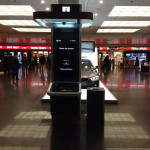This presentation from Jean Renard Ward covers the history of Pen-Based Computing from the point of view of someone in the 90s. Pretty nice to see all these old pens.
Month: December 2013
Meta-data of 30 years of CHI articles
CHI’14 results are out, for those who feel melancholic and would like to look at the evolution of CHI over time, here is the data from 1982 to 2013*. It’s not super clean but hopefully you can start to play with it. If you find errors send me an email.
There is a csv file per year, with a row per paper. Each paper has the following properties: “conference”, “year”, “doi”, “title”, “citationCount”, “download6weeks”, “download12months”, “downloadAll”, “keywords”, “pageNumber”, “authors (name, affilitiation)”
An example: “CHI”, “83”, “http://dx.doi.org/10.1145/800045.801571”, “Design principles for human-computer interfaces”, “23 “, “28”, “149”, “2,842”, “command and control languages; languages; software psychology”, “10”, “81100063003, Donald A. Norman, Department of Psychology and Institute for Cognitive Science C-015, University of California, San Diego; “
Citation and downloads counts come from the ACM DL (fetched over the past 3 days).
If you find the data useful, I’d would be nice to let me know what you used it for, and if you’re interested in the data from another conference, drop me a line.
Notes:
* I’m an ACM member believing that I’m doing a public service by gathering and publishing articles’ meta-data. If you believe otherwise, send me an email.**
** “But anyone who says that there is money to be made in a stash of ACADEMIC ARTICLES is either an idiot or a liar” Laurence Lessig
Online privacy and monadic principles
I’ve been trying to figure out how monadic principles (fr.wikipedia is actually richer) can help us think online privacy. I’m in the early stage of writing a paper on the topic, so this is really work in progress, input welcome.
The monads I’m talking about are not the functional programming ones, nor the mathematical objects, but their inspiration: the philosophical monad which could be defined both as the entity generating all other entities but also the all encompassing entity. Bear with me, for the technically inclined, know that Alan Kay mentions Leibniz’s monads as one of the inspiration for object oriented programming.
I’ll explore in upcoming posts how Tarde’s monads could be used practically to rethink the design of online socio-technical systems such as social-networks, but maybe also how to deal with online profiling/advertising tools.
Posts to come:
- Introduction to Gabriel Tarde’s monadology via Bruno Latour
- Heterarchy
- Dividuel and online identities
- The parts are greater than the whole
-
Humans and non-humans
The limits of Proxemics
A wave of recent papers draw on Hall’s Proxemics to design ubicomp systems*. The paper by Greenberg et al. “Proxemic Interactions: The New Ubicomp?” even made the cover of Interactions Magazine a few months ago, that’s quite a statement.
The ideas of proxemics are attractive, as they seem easy to operationalize**. But proxemic systems, like many ubicomp ones, rely heavily on sensing and this will always be tricky to manage. Just to give a practical example: the new macbooks, adjust the screen luminosity to the presence/closeness of a user. They measure it through variations from the light sensor placed close to the camera. I find it super frustrating to have your screen luminosity drop out of nowhere, and looking at the forum threads on the topic, I’m not the only one annoyed.
Since proxemic systems won’t work perfectly in most real-life situations, they will end up being complemented with micro-mobility management, reasoning on traces of user activity, general heuristics and fine tuning. And boom, we’re back to the sensing issues [1] described 10 years ago by Belloti et al. (2002):
- “When I address a system, how does it know I am addressing it?
- When I ask a system to do something how do I know it is attending?
- When I issue a command, how does the system know what it relates to?
- How do I know the system understands my command and is correctly executing my intended action?
- How do I recover from mistakes?”
Notes:
* Back at CHI in 2009 (not sure of the year), one of the Keynote actually presented proxemics as an inspiration for designing interaction.
** I’m not sure it’s the right operationalization though. Proxemic circles are super coarse. This might be ok for spatial interaction between people, but it sucks for interaction between people and objects, where we know that things get subtle and will be really hard to pick with sensors (see for instance Luff and Heath on micro-mobility [2]). And yes I’m aware of Nick’s great work tackling the problem.
[1] Victoria Bellotti, Maribeth Back, W. Keith Edwards, Rebecca E. Grinter, Austin Henderson, and Cristina Lopes. 2002. Making sense of sensing systems: five questions for designers and researchers. In Proceedings of the SIGCHI Conference on Human Factors in Computing Systems (CHI ’02). ACM, New York, NY, USA, 415-422.
[2] Paul Luff and Christian Heath. 1998. Mobility in collaboration. In Proceedings of the 1998 ACM conference on Computer supported cooperative work (CSCW ’98). ACM, New York, NY, USA, 305-314.
Building incentives for replication
David Karger recently posted some thoughts on replication at CHI and WWW, suggesting a mandatory replication paragraph at the end of every paper. It’s a nice idea and while it’s kind of implied in the post, a special section in the review form of reviewers and ACs might be a more manageable thing to push forward. This could offer a smoother transition and progressively help articles supporting replication stand out in PC meetings. It might also be easier to push something in the review system than asking for a specific paragraph in papers. Then the different subcommittees could decide to deal with this differently depending on their research practices.
A review section dedicated to replication could help the authors and the reviewers (who are likely authors) build a discourse on replication and data sharing (beyond people going to workshops and SIGs on replication). Hopefully over time, this would also lead to higher standards on replication and data-set quality.
I submitted a note to CHI last year with all the data and scripts (ended up at ITS). The didn’t receive any comment on the data (even critical). Sadly I ended up improving the paper but not the data which I consider to be at least half of the contribution.
Just for reference here is the text above the review field on PCS (for CHI’13), not a lot on replication:
Write your review of the paper here. Please address each of the following issues:
- Significance of the paper’s contribution to HCI and the benefit that others can gain from the contribution: why do the contribution and benefit matter?
- Originality of the work: what new ideas or approaches are introduced? We want to emphasize that an acceptable paper must make a clear contribution to Human-Computer Interaction;
- Validity of the work presented: how confidently can researchers and practitioners use the results?
- Presentation clarity;
- Relevant previous work: is prior work adequately reviewed?
If you have concerns about the methodological or statistical approaches taken by the authors, or its level of advancement over prior work, please cite a source for your objection (e.g., a definitive paper, a set of professional guidelines or a standard textbook). This is needed to help authors improve their submissions and to enable the Associate Chair to evaluate potentially conflicting reviews.
Please consider making any other recommendations that you think might be of use to the author(s).
Interacting with public displays
In Lyon’s largest mall at la Part Dieu, the maps are interactive displays. It’s the first time I felt the genuine need to use such displays. I took some time to look at people interacting with them :
- They had lots of users.
- The role of the public displays in the mall is clear, they replace traditional maps. No need to do fancy things to attract people, just but a some big signage, they come. On the other hand, I’ve been through multiple airports (i.e. Munich, Bordeaux) offering public displays and did not see anybody using them (last photo). In airports signage is usually good and you’ve got your boarding path with your personal info at hand. Until you come to the display you have no idea what they offer, and once you’re there you realize they don’t offer much…
- Public displays but personal use. People queue and use the displays the one after the other. The displays can only deal with one user, so others are left behind.
- The design is decent but really literal. The system does not really leverage its digital capabilities: I was looking for lenses’ liquid, looking up for the word lens didn’t turn any result. Search is keyword based.
- It takes quite a while to navigate and get to your answer, so some people give up waiting. If the design was improved the turn over would be higher.
- People do not look particularly excited when interacting with the displays, if there ever was a novely effect if wore out pretty quickly.
All this to say, that I sometimes wonder at all the literature trying to make generic claims on public displays. It really seems to me a case where situation, content and design have a strong impact on the interaction.


